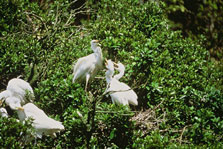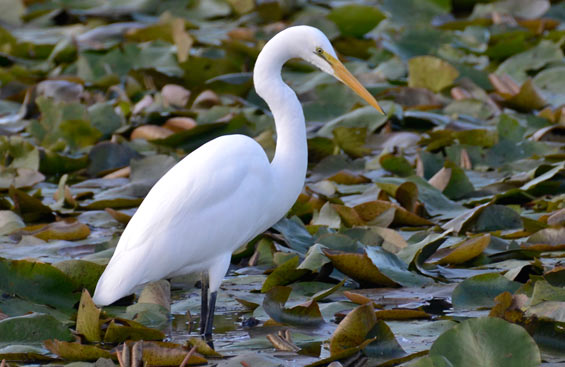
Introduction
The white heron has always been rare in New Zealand and it has gained almost mythical status.New Zealand status: Native
Conservation status: Nationally Critical
Found in: Whataroa, South Westland during breeding. After breeding seen at coastal freshwater wetlands or estuaries throughout the country.
Species information: White heron/kōtuku on NZ Birds Online
It is revered by both Māori and pakeha for its elegant white feathers. This graceful bird has long, slender legs and a long, thin S-shaped neck, which has a distinct kink when flying.
Where are they found?
The kōtuku is common in Australia, the South Pacific and Asia.
In New Zealand it only breeds near Whataroa, South Westland, between September and February. This colony is in the Waitangiroto Nature Reserve and guided tours take visitors to view the birds from an observation hide.
During the breeding season time, the birds feed in the large coastal lagoons in the area, particularly the nearby Ōkārito Lagoon.
After breeding, the birds disperse widely and may be seen at coastal freshwater wetlands or estuaries throughout the country.
White heron facts
- The kōtuku colony is located in tall kahikatea-dominated swamp forest. Birds make their nests in the crowns of tree ferns or in kōwhai or kāmahi trees.
- During breeding seasons, they grow long, loose breeding plumes from its back and wings. The normally yellow bill turns dull black, and the facial skin between the eye and bill brightens to a bluish-green.
- They are solitary feeders. At night when not feeding, they roost in trees. Their voice is the typical heron croak in flight or when disturbed.
- They feed mostly on small fish (such as whitebait), eels, frogs, shrimp, aquatic insects, mice and small birds (such as silvereyes). They may grab prey with their sharp, dagger-like beak.
- It is believed that the colony was formed by the natural introduction of birds from Australia several hundred years ago. Australian birds are still occasionally blown over in some years and augment the New Zealand population.
- The white heron is specially adapted for wading in shallow, muddy waterways: it has long legs that are bare of feathers to well above the ankle joint and long spreading toes.
- White herons have elaborate courtship displays. Males build small platforms from which they advertise themselves to females. Male displays include a spectacular raising of the nuptial plumes, with the neck erect, the bill snapping and the wing feathers flicking. Once a female is attracted, the pair preen each other and intertwine their long necks, wings and bill.
- As a symbol of things both beautiful and rare, the kōtuku occupied an important place in Māori myth and folklore, and to compare a visitor to a kōtuku was a compliment of the highest order.

White heron colony in Waitangiroto Nature Reserve

White heron
Did you know?
Because of its rarity in New Zealand and its beautiful plumage, the kōtuku was highly valued by Māori and European settlers for its ornamental feathers. The species was almost exterminated to satisfy the demand after its only breeding site on the Waitangiroto River was discovered in 1865.
By 1941 there were only four nests. At this time, the Waitangiroto site was declared a reserve and wildlife refuge and patrolled at breeding time. The managed access helps ensure the birds have every opportunity to nest undisturbed. The numbers have now stabilised with a permanent population of around 100 to 120 birds.
Sound recording
White heron/kōtuku song (MP3, 6,753K)
07:11 – 21 heron pairs and some white-throated shags nesting beside a river. Male gives harsh croak, female has soft 'who-who' call, chicks 'click-click'. Shags in the background make a softer call.
Our bird songs can be reused, even commercially, according to our copyright terms.
Threats
The white heron has always been rare in New Zealand. Why the kōtuku has not colonised a wider breeding ground is a mystery, but the current population is stable, although it experiences year-to-year fluctuations in breeding success.
Natural variables, such as storms hitting during the early part of the nesting season and the condition of the nearby Okarito Lagoon, are significant factors in determining breeding success. The kōtuku requires shallow water for feeding, and this habitat can severely reduce in certain years when the outlet of the lagoon gets blocked. The damming of the lagoon may also disrupt the migration of whitebait, which is a major food source for kōtuku.
The kōtuku colony is situated in extremely close proximity to a shag rookery and a Royal Spoonbill colony. The success of any of these three species may place pressure on the relative success of the other two.
Predators like stoats, possums and harrier hawks may threaten breeding success at various times, and control programmes are in place for both stoats and possums.
Our work
Monitoring of the nesting colony has been undertaken annually since 1944 to provide information on the health of the population over time. Currently the concessionaire that runs ecotours to the sanctuary undertakes this monitoring work on behalf of DOC.
The monitoring methodology measures what is happening with several key population parameters. It consists of recording the number of adults, nests, chicks, and fledglings present in the colony. Recordings are taken from September, when the birds arrive, to about March, when chicks fledge and birds leave.
In addition to kōtuku, the numbers and breeding success of royal spoonbills and little shags are also monitored.
You can help
White Heron Sanctuary Tours website - white heron colony tours at Waitangiroto Nature Reserve.